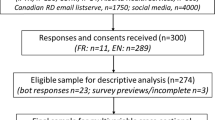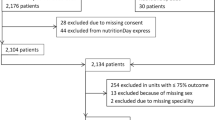Abstract
Background/objectives:
A Protected Mealtimes Programme (PMP) encourages staff, volunteers and visitors to assist patients and cease non-urgent clinical activity during mealtimes. Given the limited evidence available establishing the efficacy of PMP, we compared mealtime interruptions, mealtime assistance received and nutrient intakes before and after PMP implementation in adult inpatients on acute wards.
Subjects/methods:
Data collected on patients at main meals before and after PMP implementation included the following: diet code, level of assistance required and received and by whom, time available to consume the meal, position of the patient and tray during eating, type of interruption and by whom and proportion of foods and drinks consumed. Outcomes pre- and post-PMP implementation were compared using χ2, independent samples t-tests and logistic regression analyses.
Results:
Over two years, 1632 inpatient mealtime observations were conducted (65 (18) years, 51% M). Similar proportions of patients received mealtime assistance when required (∼84%, P=0.928). Feeding assistance nearly doubled post-PMP implementation (15–29%, P=0.002). Interruptions by nursing staff increased by 8% post-PMP implementation (P<0.001) and represented 61% of all interruptions. Interruptions were less likely to occur pre-PMP implementation (odds ratio, 0.403, 95% confidence interval, 0.301–0.539). Mealtime energy and protein intakes were not changed post-PMP (P=0.979, P=0.482, respectively).
Conclusions:
The PMP increased nursing staff availability at mealtimes and feeding assistance, but also increased mealtime interruptions. This may explain the lack of change in patient energy and protein consumption. Strategies promoting adherence with PMP implementation, such as nurse ward champions or nursing staff driving PMP implementation, may be required to maximise the benefits of protected mealtimes.
This is a preview of subscription content, access via your institution
Access options
Subscribe to this journal
Receive 12 print issues and online access
$259.00 per year
only $21.58 per issue
Buy this article
- Purchase on Springer Link
- Instant access to full article PDF
Prices may be subject to local taxes which are calculated during checkout

Similar content being viewed by others
References
Barker L, Gout B, Crowe T . Hospital malnutrition: prevalence, identification and impact on patients and the healthcare system. Int J Environ Res Public Health 2011; 8: 514–527.
Alison S . Institutional feeding of the elderly. Curr Opin Clin Nutr Metab Care 2002; 5: 31–34.
Das A, McDougall T, Smithson J, West R . Protecting mealtimes may similarly benefit elderly inpatients [letter to editor]. BMJ 2006; 332: 1334–1335.
Sydner Y, Fjellstrom C . Food provision and the meal situation in elderly care-outcomes in different social context. J Hum Nutr Dietet 2005; 18: 45–52.
Agarwal E, Ferguson M, Banks M, Batterham M, Bauer J, Capra S et al. Nutrition care practices in hospital wards: results from the Nutrition Care Day Survey 2010. Clin Nutr 2012; 31: 995–1001.
Watterson C, Fraser A, Banks M, Isenring E, Miller M, Silvester C et al. Evidence based practice guidelines for the nutritional management of malnutrition in adult patients across the continuum of care. Nutr Dietet 2009; 66: 1–34.
NHS National Patient Safety Agency. Protected Mealtimes Review – Findings and Recommendations report. 2012: http://www.nrls.npsa.nhs.uk/resources/?entryid45=59806.
Hickson M, Connolly A, Whelan K . Impact of protected mealtimes on ward mealtime environment, patient experience and nutrient intake in hospitalised patients. J Hum Nutr Dietet 2011; 24: 370–374.
Stuckey C, Bakewell L, Ford G . The effect of a protected mealtime policy on the energy intake and frequency of non-urgent interruptions during mealtimes at the Royal Bournemouth Hospital. Proc Nutr Soc 2010; 69: E526.
Weekes C . The effect of protected mealtimes on meal interruptions, feeding assistance, energy and protein intake and plate waste. Proc Nutr Soc 2008; 67: E119.
Young A, Banks M, Mudge A, Ross L, Daniels L . Protected mealtimes in the Australian context: encouraging, assisting and time to eat. Nutr Dietet 2012; 69: 24–25.
Young A, Mudge A, Banks M, Ross L, Daniels L . Encouraging, assisting and time to EAT: improved nutritional intake for older medical patients receiving protected mealtimes and/or additional nursing feeding assistance. Clin Nutr 2012; 32: 543–549.
Berrut G, Favreau AM, Dizo E, Tharreau B, Poupin C, Gueringuili M et al. Estimation of calorie and protein intake in aged patients: validation of a method based on meal portions consumed. J Gerontol A Biol Sci Med Sci 2002; 57: M52–M56.
Bjornsdottir R, Oskarsdottir E, Thordardottir F, Ramel A, Thorsdottir I, Gunnarsdottir I . Validation of a plate diagram sheet for estimation of energy and protein intake in hospitalized patients. Clin Nutr 2013; S0261-5614: 00278–6.
Forli L, Oppedal B, Skjelle K, Vatn M . Validation of a self-administered form for recording food intake in hospital patients. Eur J Clin Nutr 1998; 52: 929–933.
Bradley L, Rees C . Reducing nutritional risk in hospital: The red tray. Nurs Stand 2003; 17: 33–37.
Xyris. Foodworks 7 2012, Available at: www.xyris.com.au.
Williams P, Walton K . Plate waste in hospitals and strategies for change. Eur e-J Clin Nutr Metab 2011; 6: e235–e241.
Feldman C, Alonso Briceno-Pinar E, Konas DW, Ruskin M, Toney J, Wunderlich S . A laboratory analysis of total fat content and an examination of portion size of foods served in four New Jersey public middle-school foodservice operations. J Foodservice 2009; 20: 264–274.
Acknowledgements
We thank Queensland Health staff, the Nutrition and Dietetics team, Prince Charles hospital dietitians and inpatients. We also thank Rowena Wilson, Judith Waldburger, Yee Xuan Yet, Kendra Bow and Christine Josephson.
Author information
Authors and Affiliations
Corresponding author
Ethics declarations
Competing interests
The authors declare no conflict of interest.
Rights and permissions
About this article
Cite this article
Huxtable, S., Palmer, M. The efficacy of protected mealtimes in reducing mealtime interruptions and improving mealtime assistance in adult inpatients in an Australian hospital. Eur J Clin Nutr 67, 904–910 (2013). https://doi.org/10.1038/ejcn.2013.126
Received:
Revised:
Accepted:
Published:
Issue Date:
DOI: https://doi.org/10.1038/ejcn.2013.126
Keywords
This article is cited by
-
The efficacy of Protected Mealtimes in hospitalised patients: a stepped wedge cluster randomised controlled trial
BMC Medicine (2017)
-
Changing nutrition care practices in hospital: a thematic analysis of hospital staff perspectives
BMC Health Services Research (2017)
-
The impact of trained volunteer mealtime assistants on dietary intake and satisfaction with mealtime care in adult hospital inpatients: A systematic review
The Journal of nutrition, health and aging (2017)
-
Ernährungsmanagement in der Alterstraumatologie
Zeitschrift für Gerontologie und Geriatrie (2016)
-
Aspects of protected mealtimes are associated with improved mealtime energy and protein intakes in hospitalized adult patients on medical and surgical wards over 2 years
European Journal of Clinical Nutrition (2015)



